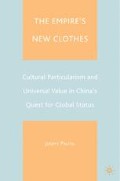Abstract
In this book I address both “fit” and “fashion”—hence the title. I focus on how China has had to restyle itself to gain recognition from an external audience that was once peripheral but is now the arbiter of fashion. A China used to turning heads before a select audience, largely of its own choosing, now seeks to turn heads far and wide. It aspires to be the fashion capital of the world and has successfully incorporated its own traditions into its designs while producing the finest cutters, seamstresses, and materials in the world. But it alone cannot decide what the “Spring Look” should be. To ensure the return of buyers, it has to keep its styles familiar. And even though the buyers are intrigued, they still flock to the runways of Paris and New York.
The most important thing in social life is how actors represent Self and Other. … Society, in short, is “what people make of it.”1
Although China cannot be said to be fully cooperative in every issue of international relations, it has pursued a more accommodative, although occasionally erratic posture over the last 150 years. Indeed the general pattern and direction of China’s international behavior, albeit more in the global political economy than in global high politics, has been a slow but steady movement from conflict to cooperation. And China is more cooperative in high-profile multilateral institutional or negotiating settings than in low profile bilateral negotiations.2
Access this chapter
Tax calculation will be finalised at checkout
Purchases are for personal use only
Preview
Unable to display preview. Download preview PDF.
Notes
Alexander Wendt, Social Theory of International Politics (Cambridge: Cambridge University Press, 1999), 332.
Samuel Kim, “China’s International Engagement at the United Nations,” in Elizabeth Economy and Michel Oksenberg, eds., China Joins the World (New York: Council on Foreign Relations, 1999), 82.
Alan James, “The Practice of Sovereign Statehood in Contemporary International Society,” Political StudiesXLVII (1999): 457.
Alastair Iain Johnston, Cultural Realism: Strategic Culture and Grand Strategy in China’s History (Princeton: Princeton University Press, 1995).
Fredrik Barth, Ethnic Groups and Boundaries: The Social Organization of Cultural Difference (London: Allen and Unwin, 1969), 16.
David Mapel and Terry Nardin, International Society: Diverse Ethical Perspectives (Princeton: Princeton University Press, 1998).
Barrett L. McCormick and David Kelly, “The Limits of Anti-Liberalism,” in The Journal of Asian Studies 53, no. 3 (August 1994): 804.
Benedict Anderson, Imagined Communities: Reflections on the Origin and Spread of Nationalism (London: Verso, 1991).
Martha Finnemore, National Interests in International Society (Ithaca, NY: Cornell University Press, 1996).
Anthony Giddens, The Nation-State and Violence (Cambridge: Polity Press, 1983), 219.
Copyright information
© 2007 Jeremy T. Paltiel
About this chapter
Cite this chapter
Paltiel, J.T. (2007). Introduction: Identifying China in International Relations. In: The Empire’s New Clothes. Palgrave Macmillan, New York. https://doi.org/10.1057/9780230605121_1
Download citation
DOI: https://doi.org/10.1057/9780230605121_1
Publisher Name: Palgrave Macmillan, New York
Print ISBN: 978-1-349-52673-4
Online ISBN: 978-0-230-60512-1
eBook Packages: Palgrave Political & Intern. Studies CollectionPolitical Science and International Studies (R0)

